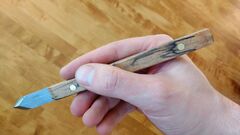Engineering:Marking knife
 Marking knife with a spear point blade | |
| Other names |
|
|---|---|
| Classification |
|
| Used with | Straightedges, squares, scratch awls, pencils |
A marking knife or striking knife is a woodworking layout tool used for accurately marking workpieces.[1] It is used to cut a visible line, which can then be used to guide a hand saw, chisel or plane when making woodworking joints and other operations.[2] They are generally used when marking across the grain of the wood, with scratch awls better suited for marking with the grain.[3]
Description
The blades on marking knives are made of tool steel, have either a skewed end or a spear point, and the knife edge is bevelled on either one side of the blade or both sides.[4] On single-bevel skewed knives the side of the blade that is bevelled dictates whether the knife is for left-handed or right-handed use, while single-bevel spear point knives are suited to both.[5]
Some marking knives incorporate a marking knife blade at one end, and a scratch awl tip at the other end – but because of this they are sometimes considered dangerous to use.[3][1]
Marking knives are either made from a single piece of steel, or additionally have a handle made of wood or plastic.
Some woodworkers make their own marking knives, for example from spade bits or planer blades.[6][7]:179
Use
Marking knives are usually held like a pencil, and are guided using a straightedge or square.[7]:175 Sometimes woodworkers will gently run a sharp pencil along the line afterwards to make it more visible.[1]
Marking knives are sharpened in a similar manner to chisels or other bladed tools – using sharpening stones, files or sandpaper.
Shirabiki
A shirabiki is a Japanese marking knife made from a single piece of steel with a skewed single-bevel blade.
A double-bladed shirabiki is used for marking parallel lines. They are made with two parallel blades and a thumbscrew for adjusting the distance between the blades.[8]
Gallery
Marking knife with a skewed blade, made from a spade bit.
Combination marking knife and scratch awl
See also
References
 |
- ↑ 1.0 1.1 1.2 Blackburn, Graham (1998). Traditional woodworking handtools : a manual for the woodworker (1st ed.). New York: Lyon Press. pp. 31–32. ISBN 1-55821-874-2. OCLC 41029219. https://www.worldcat.org/oclc/41029219.
- ↑ Rae, Andy (1 March 2008). Choosing & Using Hand Tools. Sterling Publishing Company, Inc.. pp. 63–64. ISBN 978-1-60059-274-4. https://books.google.com/books?id=W2SvquJVmi4C&pg=PA63.
- ↑ 3.0 3.1 Salaman, R. A. (1975). Dictionary of tools used in the woodworking and allied trades, c. 1700-1970. Internet Archive. New York, USA: Scribner. pp. 269. ISBN 978-0-684-14535-8. https://archive.org/details/dictionaryoftool0000sala.
- ↑ Liberman, Yoav (2015-05-28). "An Intro to Marking Knives: Part One" (in en-US). https://www.popularwoodworking.com/woodworking-blogs/an-intro-to-marking-knives-part-one/.
- ↑ "Spear-point Marking Knives" (in en-US). 2013-01-24. https://www.popularwoodworking.com/tools/spear-point-marking-knives/.
- ↑ Liberman, Yoav (2013-09-30). "Making a marking knife from an old planer blade - part 1" (in en-US). https://www.popularwoodworking.com/american-woodworker-blog/making-a-marking-knife-from-an-old-planer-blade-part-1/.
- ↑ 7.0 7.1 Thiel, David, ed (2007). Hand tool essentials: refine your power tool projects with hand tool techniques (1st ed.). Cincinnati, Ohio, USA: Popular Woodworking Books. pp. 174–179. ISBN 978-1-55870-815-0. OCLC 76871452. https://www.worldcat.org/oclc/76871452.
- ↑ Ōdate, Toshio (1998). Japanese woodworking tools : their tradition, spirit, and use (1st Linden Publishing ed.). Fresno, California: Linden Publishing. pp. 29–30. ISBN 0-941936-46-5. OCLC 38286556. https://www.worldcat.org/oclc/38286556.



